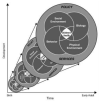Recommendations for Assessment of Environmental Exposures in Longitudinal Life Course Studies Such as the National Children's Study
- PMID: 33996684
- PMCID: PMC8116497
- DOI: 10.3389/fped.2021.629487
Recommendations for Assessment of Environmental Exposures in Longitudinal Life Course Studies Such as the National Children's Study
Abstract
An important step toward understanding the relationship between the environment and child health and development is the comprehensive cataloging of external environmental factors that may modify health and development over the life course. Our understanding of the environmental influences on health is growing increasingly complex. Significant key questions exist as to what genes, environment, and life stage mean to defining normal variations and altered developmental trajectories throughout the life course and also across generations. With the rapid advances in genetic technology came large-scale genomic studies to search for the genetic etiology of complex diseases. While genome-wide association studies (GWAS) have revealed genetic factors and networks that advance our understanding to some extent, it is increasingly recognized that disease causation is largely non-genetic and reflects interactions between an individual's genetic susceptibility and his or her environment. Thus, the full promise of the human genome project to prevent or treat disease and promote good health arguably depends on a commitment to understanding the interactions between our environment and our genetic makeup and requires a design with prospective environmental data collection that considers critical windows of susceptibility that likely correspond to the expression of specific genes and gene pathways. Unlike the genome, which is static, relevant exposures as well as our response to exposures, change over time. This has fostered the complementary concept of the exposome ideally defined as the measure of all exposures of an individual over a lifetime and how those exposures relate to health. The exposome framework considers multiple external exposures (e.g., chemical, social) and behaviors that may modify exposures (e.g., diet), as well as consequences of environmental exposures indexed via biomarkers of physiological response or measures of behavioral response throughout the lifespan. The exposome concept can be applied in prospective developmental studies such as the National Children's Study (NCS) with the practical understanding that even a partial characterization will bring major advances to health. Lessons learned from the NCS provide an important opportunity to inform future studies that can leverage these evolving paradigms in elucidating the role of environment on health across the life course.
Keywords: environmental exposures; exposure assessment; longitudinal research; pediatric longitudinal research; psychosocial environment.
Copyright © 2021 Viet, Dellarco, Chen, McDade, Faustman, Brachvogel, Smith and Wright.
Conflict of interest statement
The authors declare that the research was conducted in the absence of any commercial or financial relationships that could be construed as a potential conflict of interest.
Figures



Similar articles
-
Lessons learned for the National Children's Study from the National Institute of Environmental Health Sciences/U.S. Environmental Protection Agency Centers for Children's Environmental Health and Disease Prevention Research.Environ Health Perspect. 2005 Oct;113(10):1414-8. doi: 10.1289/ehp.7669. Environ Health Perspect. 2005. PMID: 16203257 Free PMC article.
-
Toward Greater Implementation of the Exposome Research Paradigm within Environmental Epidemiology.Annu Rev Public Health. 2017 Mar 20;38:315-327. doi: 10.1146/annurev-publhealth-082516-012750. Epub 2017 Jan 6. Annu Rev Public Health. 2017. PMID: 28125387 Free PMC article. Review.
-
Adopting a child perspective for exposome research on mental health and cognitive development - Conceptualisation and opportunities.Environ Res. 2023 Dec 15;239(Pt 1):117279. doi: 10.1016/j.envres.2023.117279. Epub 2023 Sep 29. Environ Res. 2023. PMID: 37778607
-
Use of an Exposome Approach to Understand the Effects of Exposures From the Natural, Built, and Social Environments on Cardio-Vascular Disease Onset, Progression, and Outcomes.Front Public Health. 2020 Aug 12;8:379. doi: 10.3389/fpubh.2020.00379. eCollection 2020. Front Public Health. 2020. PMID: 32903514 Free PMC article. Review.
-
The Exposome Paradigm in Human Health: Lessons from the Emory Exposome Summer Course.Environ Health Perspect. 2017 Jun 29;125(6):064502. doi: 10.1289/EHP1712. Environ Health Perspect. 2017. PMID: 28669935 Free PMC article.
References
-
- Genes Behavior and the Social Environment. Washington, DC: National Academies Press; (2006). - PubMed
Grants and funding
LinkOut - more resources
Full Text Sources
Other Literature Sources

